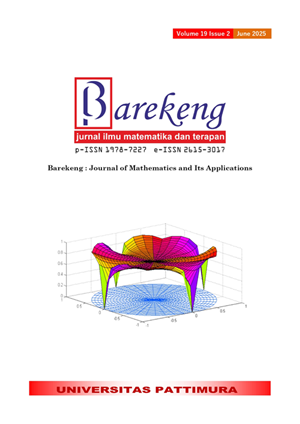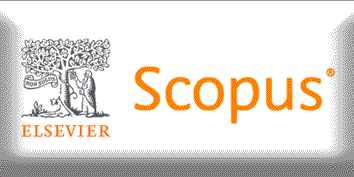INTRODUCTION TO DOMINO KLEIN-4 GROUP CRYPTOGRAPHY
Abstract
As a type of simple group in mathematics, the concept of the Klein-4 group finds applications in various fields such as biology, 2D materials, games, and more. This research combines the idea of the Klein-4 group with the rules of domino cards to create a binary operation. This binary operation serves as the encryption key, and its inverse serves as the decryption key. The comprehensive process in this study represents a novel application of the Klein-4 group in cryptography. By leveraging the structural properties of the Klein-4 group, this method introduces a unique approach to securing information. The combination of group theory and modular forms in this study enhances the complexity of the encryption and decryption processes, making it more difficult for unauthorized parties to access or interpret the data. As a result, the security of the data is significantly improved. The encryption algorithm is not only efficient but also resistant to common cryptographic attacks. This study demonstrates the potential of abstract algebraic concepts in developing practical solutions for modern-day cryptographic challenges. The research methods and proposed hypotheses in this study have been validated through the proof of the given theorems. However, this study limits the data to alphabet. Researchers interested in the field of cryptography can further develop this idea to apply cryptographic processes to other types of data.
Downloads
References
P. Goyat and D. A. K. Malik, “GROUP THEORY AND ITS APPLICATION FOR SOLVING COMPLEX MATHEMATICAL PROBLEM,” Turkish Journal of Computer and Mathematics Education, vol. 11, no. 01, pp. 340–345, 2020.
M. N. Husni, H. Syafitri, A. M. Siboro, A. G. Syarifudin, Q. Aini, and I. G. A. W. Wardhana, “THE HARMONIC INDEX AND THE GUTMAN INDEX OF COPRIME GRAPH OF INTEGER GROUP MODULO WITH ORDER OF PRIME POWER,” BAREKENG: Jurnal Ilmu Matematika dan Terapan, vol. 16, no. 3, pp. 961–966, Sep. 2022, doi: 10.30598/barekengvol16iss3pp961-966.
L. R. W. Putra, Z. Y. Awanis, S. Salwa, Q. Aini, and I. G. A. W. Wardhana, “THE POWER GRAPH REPRESENTATION FOR INTEGER MODULO GROUP WITH POWER PRIME ORDER,” BAREKENG: Jurnal Ilmu Matematika dan Terapan, vol. 17, no. 3, pp. 1393–1400, Sep. 2023, doi: 10.30598/barekengvol17iss3pp1393-1400.
A. S. Bawana, A. Sutjijana, and Y. Susanti, “ON THE GIRTH, INDEPENDENCE NUMBER, AND WIENER INDEX OF COPRIME GRAPH OF DIHEDRAL GROUP,” BAREKENG: Jurnal Ilmu Matematika dan Terapan, vol. 17, no. 3, pp. 1695–1702, Sep. 2023, doi: 10.30598/barekengvol17iss3pp1695-1702.
D. S. Ramdani, I. G. A. W. Wardhana, and Z. Y. Awanis, “THE INTERSECTION GRAPH REPRESENTATION OF A DIHEDRAL GROUP WITH PRIME ORDER AND ITS NUMERICAL INVARIANTS,” BAREKENG: Jurnal Ilmu Matematika dan Terapan, vol. 16, no. 3, pp. 1013–1020, Sep. 2022, doi: 10.30598/barekengvol16iss3pp1013-1020.
E. A. Rietman, R. L. Karp, and J. A. Tuszynski, “REVIEW AND APPLICATION OF GROUP THEORY TO MOLECULAR SYSTEMS BIOLOGY,” Theor Biol Med Model, vol. 8, no. 1, 2011, doi: 10.1186/1742-4682-8-21.
M. Y. H. Widianto and M. Saito, “APPLICATIONS OF DOUBLE GROUP THEORY IN 2D MATERIALS,” International Journal of Computing Science and Applied Mathematics, vol. 9, no. 2, p. 60, 2023.
A. Saragih and S. Chintia Purba, “APPLICATION OF KLEIN-4 GROUP ON DOMINO CARD,” International Journal of Applied Sciences and Smart Technologies, vol. 2, no. 1, pp. 67–74, 2020.
T. Wang and Z. Xu, “THE APPLICATION OF GROUP THEORY BEHIND MODERN CRYPTOGRAPHY,” Theoretical and Natural Science, vol. 13, no. 1, pp. 195–201, Nov. 2023, doi: 10.54254/2753-8818/13/20240844.
M. Ravi, “THE ROLE OF GROUP THEORY IN MODERN CRYPTOGRAPHY,” J Emerg Technol Innov Res, 2023, [Online]. Available: www.jetir.org
P. Arora, “USE OF GROIP THEORY IN CRYPTOGRAPHY,” International Journal of Advance Research and Innovative Ideas in Education(IJARIIE), vol. 2, no. 6, 2016, [Online]. Available: www.ijariie.com
S. R. Blackburn, C. Cid, and C. Mullan, “GROUP THEORY IN CRYPTOGRAPHY,” Jun. 2009, [Online]. Available: http://arxiv.org/abs/0906.5545
D. Kahrobaei, R. Flores, and M. Noce, “GROUP-BASED CRYPTOGRAPHY IN THE QUANTUM ERA,” American Mathematics Society, 2022.
J. Amreen and S. Naduvath, “ORDER SUM GRAPH OF A GROUP,” Baghdad Science Journal, vol. 20, no. 1, pp. 181–188, 2023, doi: 10.21123/bsj.2022.6480.
G. T. Lee, ABSTRACT ALGEBRA-AN INTRODUCTORY COURSE. Switzerland: Springer, 2018. [Online]. Available: http://www.springer.com/series/3423
M. M. Romsery, H. W. M. Patty, and M. W. Talakua, “IDENTIFIKASI BASIS GRÖBNER DALAM IDEAL RING POLINOMIAL,” BAREKENG: Jurnal Ilmu Matematika dan Terapan, vol. 9, pp. 11–20, 2015.
G. R. Pérez Teruel, G. R. Pérez, T. Communicated, J. Luis, and L. Bonilla, “MATRIX OPERATORS AND THE KLEIN FOUR GROUP,” Palestine Journal of Mathematics, vol. 9, no. 1, pp. 402–410, 2020, [Online]. Available: https://www.researchgate.net/publication/336995210
M. P. Lobo, “EVERY GROUP IS ISOMORPHIC TO A GROUP OF PERMUTATIONS,” Open Journal of Mathematics and Physics, vol. 3, pp. 1–7, 2021, doi: 10.31219/osf.io/63pmy.
M. Kobayashi, “HOPFIELD NEURAL NETWORKS USING KLEIN FOUR-GROUP,” Neurocomputing, vol. 387, pp. 123–128, Apr. 2020.
S. S. Carita and H. Kabetta, “MODIFICATION OF POLLARD RHO ALGORITHM USING NEGATION MAPPING,” BAREKENG: Jurnal Ilmu Matematika dan Terapan, vol. 16, no. 4, pp. 1159–1166, Dec. 2022, doi: 10.30598/barekengvol16iss4pp1159-1166.
P. Sharma, K. Yadav, and A. Kumar Tiwari, “A REVIEW PAPER ON NETWORK SECURITY AND CRYPTOGRAPHY,” World Journal of Research and Review (WJRR), vol. 14, no. 5, pp. 20–14, 2022, [Online]. Available: www.wjrr.org
W. Stallings, Cryptography and Network Security - Principles and Practice, Seventh Edition. India: Pearson Education India, 2017.
M. U. Bokhari and Q. M. Shallal, “A REVIEW ON SYMMETRIC KEY ENCRYPTION TECHNIQUES IN CRYPTOGRAPHY,” Int J Comput Appl, vol. 147, no. 10, pp. 975–8887, 2016.
S. A. Ahmad and A. B. Garko, “HYBRID CRYPTOGRAPHY ALGORITHMS IN CLOUD COMPUTING: A REVIEW,” 15th Int. Conf. on Electronics, Computer and Computation (ICECCO), pp. 1–6, 2019.
M. A. Al-Shabi, “A SURVEY ON SYMMETRIC AND ASYMMETRIC CRYPTOGRAPHY ALGORITHMS IN INFORMATION SECURITY,” International Journal of Scientific and Research Publications (IJSRP), vol. 9, no. 3, p. p8779, Mar. 2019, doi: 10.29322/ijsrp.9.03.2019.p8779.
F. Bentil and I. Lartey, “CLOUD CRYPTOGRAPHY-A SECURITY ASPECT,” International Journal of Engineering Research & Technology (IJERT), vol. 10, no. 05, pp. 448–450, 2021, [Online]. Available: http://aka.ms/mgmtcloud
D. B. Ginting, “PERANAN ARITMETIKA MODULO DAN BILANGAN PRIMA PADA ALGORITMA KRIPTOGRAFI RSA,” Media Informatika, vol. 9, no. 2, pp. 48–57, 2010.
V. C. Datey, “STEP FUNCTION MODEL FOR FORECASTING PROJECT CASH FLOW,” International Journal of scientific research and management (IJSRM) , vol. 3, no. 4, pp. 2812–2815, 2015, [Online]. Available: www.ijsrm.in
D. R. Stinson and M. B. Paterson, CRYPTOGRAPHY THEORY AND PRACTICE FOURTH EDITION, Fourth Edition. Florida, United States: CRC Press, 2019.
Copyright (c) 2025 Asido Saragih, Regina Ayunita Tarigan

This work is licensed under a Creative Commons Attribution-ShareAlike 4.0 International License.
Authors who publish with this Journal agree to the following terms:
- Author retain copyright and grant the journal right of first publication with the work simultaneously licensed under a creative commons attribution license that allow others to share the work within an acknowledgement of the work’s authorship and initial publication of this journal.
- Authors are able to enter into separate, additional contractual arrangement for the non-exclusive distribution of the journal’s published version of the work (e.g. acknowledgement of its initial publication in this journal).
- Authors are permitted and encouraged to post their work online (e.g. in institutional repositories or on their websites) prior to and during the submission process, as it can lead to productive exchanges, as well as earlier and greater citation of published works.






1.gif)



